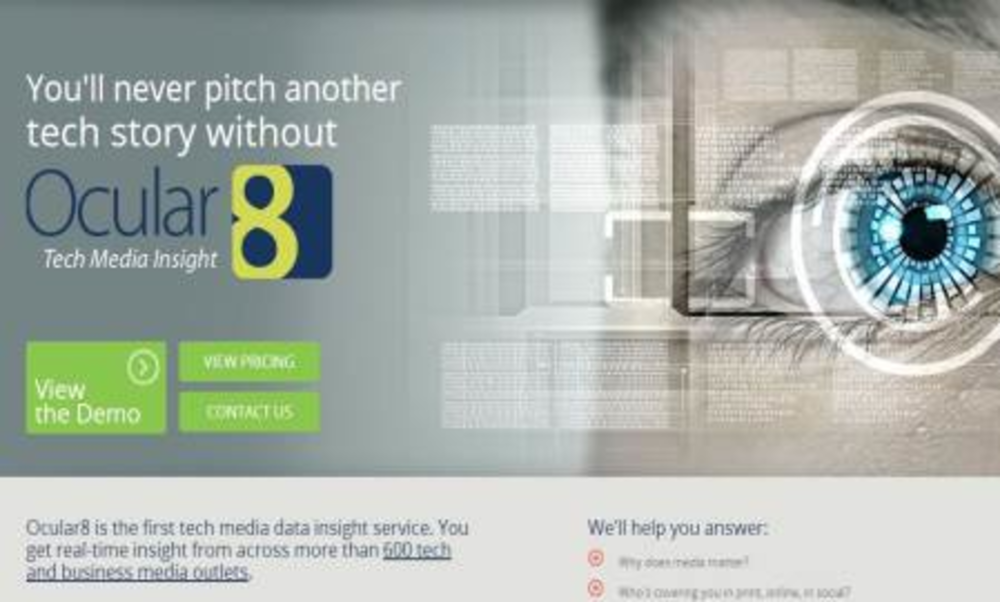Last Monday, PRSourceCode announced the availability of Ocular8, a media analysis and tracking tool or “Super Spider” built exclusively for tech companies and the agencies that represent them. The platform provides real-time insight on topics being covered by the technology press, and how a brand’s “share of voice” compares to industry competitors.
PRSourceCode is a familiar name to many PR professionals due to its suite of PR products that include customized editorial calendars, and speaker and award placement calendars. Ocular8 represents the firm’s foray into what has become a crowded category of media monitoring and social media influencer tools that help brands and agencies focus resources and energy towards media and influencers with the greatest impact and reach.
While the number of publications and editorial contacts continue to decline as a result of plummeting traditional advertising and the shift from print to digital, the need to effectively track brand coverage shows little sign of abating. The press release announcing Ocular8 cites a PRSourceCode survey found that coverage tracking consumes 5-20 percent of PR budgets. That is a really wide range, but few would disagree that most free tools to track coverage such as Google Alerts are insufficient, and even existing media database services periodically suffer from outdated media contact information (i.e. – you send an email to a reporter only to find out he passed away in 2007, or more likely, has left the editorial side altogether and is now “content curator” for some well-known technology brand).
Over the past several days, I’ve been testing Ocular8. As is the case with any new tool, the product will evolve over the next several months in response to user feedback, new features and capabilities to create an enhanced user experience. This review is focused on where Ocular8 fits into a cluttered and in some cases overlapping set of offerings, and how it is attempting to position itself within the PR professional’s toolkit.
Key Capabilities
The Ocular8 dashboard, at present, includes a pair of integrated tools. The Coverage tool allows the user to enter either a single or multiple search terms, and generate media reports that include most every print, online or blog piece including that search term. The user can then directly link to each article within the dashboard.
This capability is similar in nature to what other tools such as ITDatabase provide, and can be useful for technology companies and agencies looking to gain real-time insight into the topics and/or competitors being covered by particular reporters and bloggers.
A more differentiating aspect of the Coverage tool is the ability to filter these articles and blog posts by number of Twitter, Facebook or LinkedIn mentions. This capability is distinguished from most social media influencer tools, which tend to rank influencers by, their volume of Twitter followers or LinkedIn Connections. That can tell you who exerts a great deal of social media muscle, but it doesn’t get to which articles are socially shared the most, or the topics and article authors that are resonating with readers by being extended through social media.
The ability to filter reports by volume of social shares is appealing and functional, because it provides a more holistic view of the types of stories which are resonating and creating a social media “action.” This metric is even more relevant today, when PR practitioners can no longer rely on an article mention generating impact on its own volition. Today, there is a need to more proactively circulate and extend this content, and by understanding which story angles and reporters have the most momentum, it can make this requirement easier to achieve.
The second tool in the Ocular8 dashboard is Share Of Voice. This tool also allows the user to enter single or multiple keywords and phrases, but the goal here is to analyze a brand’s “share of voice” relative to competitors. It can then also generate “share of voice” reports and charts. The user can view pie chart representations of a brand’s share of voice relative to competitors, or run reports on share of voice of particular topics and phrases to see how frequently these terms are being used.
The Share of Voice tool, at present, goes back one month, but every time you run an SOV search, it will save it on the results and you can click on each separately to view results over time. This way you can easily see how results have changed since the initial search, similar to how the coverage tracker is used.
In addition to Ocular8, the demo also previewed a future set of periodic reports the company plans to provide that shows more detailed analysis of share of voice by diving deeper into topic areas (big data, mobile, Cloud, etc.). The company also says Ocular8 will eventually provide the ability to analyze coverage tone (positive/negative/neutral) – a feature that will put Ocular8 in stronger standing with other media monitoring and analysis offerings on the market.
Pricing
Many of today’s popular tools – ranging from Radian6 and SproutSocial for social media management to Topsy and Social Mention for social media aggregation, offer some overlapping capabilities. This creates the need to adopt a single tool or portfolio of tools that deliver complementary rather than redundant benefits in order to make the best use of budgets.
Ocular8 is priced in line with similar user level subscriptions for tools such as Vocus and Radian6, roughly $1,000 per month for a single user or very small number of concurrent users. The publicly quoted pricing for Ocular8 is $1,000/month; $5,000/six months or $9,000/year for single users – with volume discounting available for ten or more users.
As PRSourceCode was quick to point out, Ocular8 is not built to directly compete with a Vocus or Radian6; more likely, brands and agencies will leverage Ocular8 as part of a toolset optimized for their specific needs and budget.








